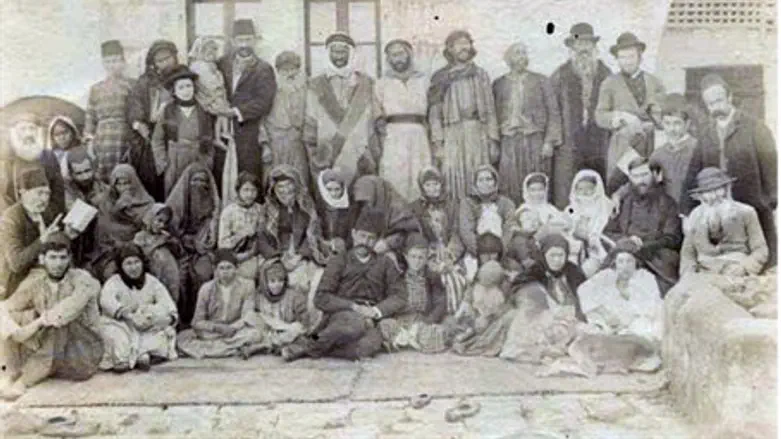
The picture on the main page and to the right is of Jews in Tiberias in 1886, waiting for medical care outside the Scottish mission hospital. The contrast with the picture below, taken three decades later, shows the changes in the Jewish community.
The "Mukhtar" and the Varhaftig-Amitai family of Tiberias, 1917 *Mukhtar means "chosen" in Arabic and refers to the head of a village in many Arab countries and Turkey.
Morris Amitay of the Washington DC area sent this picture of his Tiberias ancestors in 1917. He wrote:
The picture was taken in 1917 before the Turks fled Palestine and Allenby marched in. The old man in the middle was my father’s grandfather – and the “mukhtar” of the Ashkenazi community in Tiberias appointed by the Turks. His wife is alongside, and my dad’s sister is in front.
The “Alter Mukhtar” was Alter Pinchas Elazar, and the family name was gradually being changed at the time from Varhaftig to Amitai [later to Amitay]. His wife was Freidl and his granddaughter (my father’s sister) was Sara. In the back row from left to right are Yehoshua, Yona, Asher, Yitzhak and Leibl.
Note the diversity of my father's uncles! A Turkish soldier, hassid, two Turkish businessmen (fez and all), and one perhaps "Modern Orthodox."
Gravestone of Ya'akov Moshe Varhaftig in Tiberias (source: Morris Amitay). Nava Safrai's family history explains that he was a pharmacist who died in a cholera epidemic. He
saved many during the epidemic, Safrai writes.
One son, Amitay's grandfather, Ya'akov Moshe, passed away in 1902. A tombstone on his grave reads:
Here is buried the young Talmud scholar (avrech), our dear grandfather Ya'akov Moshe Varhaftig-Amitai, son of Alter Pinchas Eliezer, mukhtar, grandson of Avraham Peretz Moshe, died 2 Heshvan 5663 (November 2, 1902).
The "Alter Mukhtar" of Tiberias, Pinchas Elazar Varhaftig-Amitai, 1916. (Source: Morris Amitay)
Morris Amitay wrote that his father was proud of his "family's origins in 'Palestine' in 1777."
Research done by one of Amitay's cousins reports, "The Varhaftigs originated from Slonim, (near Minsk and Vilnius) in Lithuania. They departed February, 1777 for Palestine via Turkey, arriving six months later in Acco. They settled in Safed until 1781, and then moved to Tiberias."
According to another family account published in Israel by Nava Safrai, a granddaughter of Sara from the 1917 picture, the Varhaftigs arrived in 1808 from Pinsk.
A wave of Hassidic "aliya" to Eretz Yisrael took place in the latter part of the 18th century and early 19th century, including the son of the "Karliner Rebbe." The Varhaftig family belonged to the Karliner Hassidic group, and one member of the family, Mordechai Wolf, traveled to Tzfat to visit a leading Karliner rabbi in 1837. A catastrophic earthquake hit, destroying much of Tzfat and killing Mordechai Wolf.
Alter Pinchas Amitai (born 1851) was appointed the "Mukhtar" (village elder) of Tiberias in 1891 by the Turks. According to Safrai, the "Alter Mukhtar" was forced from the position by the Turks because of his forging documents to help Jews avoid the Turkish draft.
Note that one son in the 1917 family portrait was a Turkish soldier or policeman, perhaps precisely because of his father's experience with the Turkish authorities.
We also present an 1886 picture of Tiberias, part of our photo essay on Jewish life in the Galilee town. We uncovered this picture in the photo archives of the University of Dundee Medical School.
Patients waiting outside of the Scottish Mission hospital in Tiberias, 1886. (Torrance Collection)
Postscript: Morris Amitay, a descendant of Tiberias Jews, was a senior aide to U.S. Senator Abe Ribicoff of Connecticut. The only other Jewish senator at the time was Jacob Javits of New York. Javits mother, Ida Littman, was originally from Tzfat, not far from Tiberias. Amitay went on to head the American Israel Public Affairs Committee in Washington.


